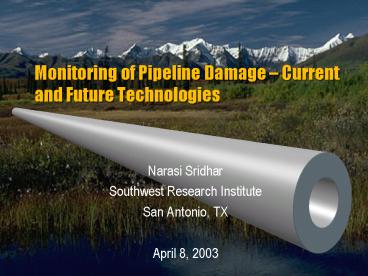Monitoring of Pipeline Damage Current and Future Technologies - PowerPoint PPT Presentation
1 / 16
Title:
Monitoring of Pipeline Damage Current and Future Technologies
Description:
Assessment of Recent Research Directions. Requirements for Monitoring Systems ... Complex geometries, airworthiness issues. Limited size scale. Power Plants ... – PowerPoint PPT presentation
Number of Views:428
Avg rating:3.0/5.0
Title: Monitoring of Pipeline Damage Current and Future Technologies
1
Monitoring of Pipeline Damage Current and
Future Technologies
- Narasi Sridhar
- Southwest Research Institute
- San Antonio, TX
- April 8, 2003
2
Pipeline Damage Monitoring
- Industry Challenges, Vision, and Goals
- Current Status
- Assessment of Recent Research Directions
- Requirements for Monitoring Systems
- Other Industry Technologies
- Planning the Future
3
Industry Technology Challenges
From DOE Natural Gas forum, September 2000
- Improve monitoring and assessment of system
integrity - Enhance system flexibility and throughput
- Reduce incidence and cause of subsurface damage
- Improve capability of cost effective construction
- Improve data quality for system planning and
regulatory acceptance
4
RD Gaps and Funding Focus
OPS Workshop, 11/27/2001
- RD planning for longer time horizon
- Integrity management tools for distribution
companies - Improved Leak Detection and Mitigation
- Development of Direct Assessment Methods
- Real-time monitoring of Pipeline Integrity
Factors
5
Most Important RD Areas
OPS Workshop, 11/27/2001
- Improved In-Line Inspection Technologies
- Real-Time Detection of Incipient Third-Party
Damage - Improved Data Integration Methods
- Improved Methods to Characterize External
corrosion
6
Monitoring Needs Informal Survey
- Non-intrusive monitoring of internal corrosion
- Above-ground techniques to monitor active
corrosion - Early (real-time) detection of third party
intrusion - Above ground techniques for CP shielding
- Continuous monitoring of internal corrosion
- Monitoring of soil movement
7
Assessment of Current Research/ Technologies
- Existing Pipelines
- Future Pipe Installations
8
Overall Assessment of Damage Monitoring
- Existing Pipe, Above Ground (no excavation)
- No continuous, damage monitoring technique exists
- No publicized research
- Existing Pipe, Excavation to Access Pipe (ILI not
included) - Several techniques being investigated
- New Pipe
- Several techniques being investigated
9
Existing and New Pipelines
- Satellite-based Imaging Technology
- Pickles et al. (LLNL) DOE-funded program uses
spectral imaging to detect changes in vegetation
due to leaks. Other geomorphological changes - Can not detect pipeline damage without leaks
- Fiber Optic Technologies
- Huebler (GTI) DOE-funded program uses optical
time domain reflectometry to detect unauthorized
construction near pipelines - Detects intrusive activity, not damage
10
Existing and New Pipelines
- Electrochemical Sensors
- Holcomb et al. (Albany Research) DOE funded
program employs electrochemical noise method to
detect internal and external corrosion - Yang et al. (SwRI) Internal funded program uses
multielectrode array sensor to detect internal
corrosion - Ultrasonic/Acoustic Techniques
- Light et al. (SwRI) DOE-funded program uses
magnetostrictive sensor mounted on pipelines to
detect internal/external corrosion
11
Existing or New Pipes
- Electrical Resistance Methods
- CorrOcean Field Signature Method monitors
resistance changes of an instrumented section
installed inline with pipe - FinoAG NoPig technology monitors changes in
field asymmetry due to differences between high
and low-frequency currents along pipe wall
12
New Pipes
- Carrington et al. (INEEL) DOE-funded program
evaluates a multi-layered coating system with
thermal-sprayed conductive interlayer which
change resistance upon straining. - Revie et al. (Canmet) Fiber optic system
13
Learning From Other Industries ?
- Chemical Process Industry
- Real-time monitoring common
- Limited geographical boundary, above ground
access - Aerospace Industry
- Real time monitoring limited and new
- Complex geometries, airworthiness issues
- Limited size scale
- Power Plants
- Real-time monitoring common
- Limited geographical boundary, above ground
access - Highway Infrastructure
- Real time monitoring experimental (at least for
damage) - Geographically extensive, but critical areas
isolated (bridges, overpasses)
14
Unique Challenge of Pipelines
- Extensive lengths
- Buried
- Coated
- Hazardous if penetrated by sensors
- Uneconomical to excavate frequently
- Desirable to incorporate new technologies in
existing manufacturing infrastructure
15
Potential New Technologies
- RF tagged sensors introduced in gas stream
- Micro-encapsulated coatings
- Embedded sensors/coating modifiers
- Self-healing agents
- Interspersed, instrumented, pipe sections
Gas Stream Tagged
Damage Location
Regular Pipe
Instrumented Section
Regular Pipe
16
Concluding Remarks
- Seek technologies used by other industry
- Monitoring should be combined with modeling
- Helps interpret information
- Assists in locating sensors at critical points
- Monitoring should yield output that eases
decision-making - Several technologies are being pursued, but
monitoring of existing piping without excavation
is not addressed adequately































